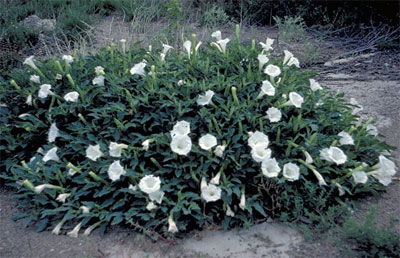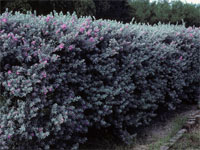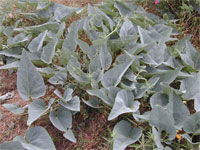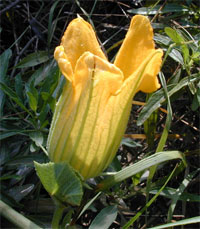Wild About Texas – July, 2010

Datura wrightii. Sacred thorn-apple, Jimsonweed, Datura, Angel trumpet, Sacred datura. Photo by Campbell and Lynn Loughmiller. Closeup photo on the main page of e-gardens by Joe Marcus.
Keeping Cool with Silver
It’s August in Texas, and it is hot! How do plants deal with the intense heat and light of summer sun? They can’t run away and hide, but many of them create their own shade by sprouting fine hairs or waxy coatings on their leaves, giving an ashen cast that reflects light and keeps plants cooler. This armor against the elements also helps trap valuable moisture and insulate leaves from drying winds.
Coincidentally, these survival strategies can result in some appealing offerings for the garden. Longwood Gardens in Pennsylvania validates this point handily in their Silver Garden, designed by California landscape architect Isabelle Greene. The contrasting textures and plant forms, all in shades of gray and silver, create refreshing and sophisticated examples. This ambiance can be exaggerated in any garden with gelid blue, lavender, and white flowers combined with frosty foliage.
Plants with similar colors look best when chosen for contrasting leaf size (texture) and overall plant shapes (forms). Try some of these plants for your cool silver garden:

Leucophyllum frutescens. Photo by Andy and Sally Wasowski.

Opuntia ellisiana (with Lindheimer muhly and silver-leaf primrose in background).

Stemodia lanata. Photo by Joe Marcus.

Cucurbita foetidissima, foliage. Photo by Joe Marcus.

Cucurbita foetidissima, flower just opening. Photo by Joe Marcus.
Cenizo (Leucophyllum frutescens) is one of the most heat-tolerant and robust shrubs for our climate in the southern half of the state. The common name, “cenizo,” is Spanish for “ashen” and the genus name, “leuco-phyllum,” translates from the Latin as “white leaf.” How descriptive is that? It’s a bonus when the shrubs periodically explode with lavender flowers throughout the summer.
Jimsonweed or thorn-apple (Datura wrightii, D. inoxia) is a fragrant night bloomer with gray-green foliage and large, white trumpet-shaped flowers. A robust perennial in warmer areas, it is cold-tender farther north but reseeds readily. Check it out at night with a flashlight. You are apt to see some very large sphinx moths enjoying the nectar.
Silverleaf sunflower (Helianthus argophyllus) is a warm-season annual that looks and acts much like the common annual sunflower, except it has silky, white leaves. The course texture dramatically complements other foliage.
Lindheimer or big muhly (Muhlenbergia lindheimeri) and many other steely leafed grasses such as yellow indiangrass, little bluestem, switchgrass, and other muhlys lend a soft, graceful and flowing element to a garden.
Spineless prickly pear (Opuntia ellisiana) and various Agave species supply strong, bold shapes and are virtually no-maintenance. Native species are generally cold-hardy in most of the state, but many Mexican species that are commercially available may not survive without winter protection.
Silver ponyfoot (Dichondra argentea) and wooly stemodia (Stemodia lanata) are two popular low-growing groundcovers with trailing stems that root at the nodes, creating a solid blanket of white. Both look exceptionally striking growing over stones or the side of a pot.
Buffalo or stinking gourd (Cucurbita foetidissima) will prompt some of you to raise your eyebrows at my suggestion to actually plant this indestructible trailing vine, but I have become smitten with it so long as I don’t have to spend too much time in close proximity to it. It really does reek! And the enormous root perniciously resists extraction from the ground. If I haven’t scared you off yet, perhaps you can appreciate the crisply creased heart-shaped leaves and luminous orange flowers in summer.
Old man’s beard (Clematis drummondii) is another under-used vine and, though it doesn’t have particularly cinereous leaves, the silky awns on the seed clusters inspired the common name and are quite eye-catching.
One last tip: all that silver we just discussed will be best set off by a dark and even backdrop, such as a wall of deep green shrubs like junipers, Texas mountain laurel, dwarf palmetto, or wax myrtle. Carolina jessamine growing on a fence or trellis will also do the trick.
For more information about Texas native plants, visit the Wildflower Center’s website at www.wildflower.org.
About the author: Andrea DeLong-Amaya is the director of horticulture at the Lady Bird Johnson Wildflower Center in Austin.
